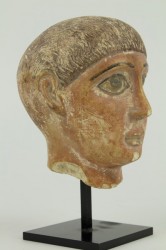The Vanderbilt University Fine Arts Gallery announces “Up Close and Personal: Intimate Devotions and Everyday Objects in Late Antiquity,” an exhibition curated by Vanderbilt students that explores the devotional traditions of individuals who practiced Judaism, Christianity and Roman religions from the first century B.C.E. to the seventh century C.E.
An opening reception will be held on May 7 from 2 to 4 p.m. in Cohen Memorial Hall in conjunction with the Department of History of Art’s graduation celebration. The reception and exhibition are free and open to the public. The exhibition will remain on view until Sept. 4.
The Fine Arts Gallery is located in Cohen Memorial Hall, 1220 21st Ave. S., on the western edge of the Peabody College campus. Summer gallery hours are Tuesday–Friday, noon–4 p.m.; Saturday, 1–5 p.m.; and closed on Sunday and Monday. Beginning Aug. 26, the Fine Arts Gallery will assume academic year hours: Monday–Friday, 11 a.m. –4 p.m.; and Saturday and Sunday, 1–5 p.m.
Most of our modern knowledge about religion in the first centuries of the Common Era comes from temples, churches, ruins, large public statues, catacombs and cemeteries. This is only a portion of the story, though. “Up Close and Personal” studies the world of average families and their religious practices through the small, personal objects that have survived through the centuries to the present day.
On loan from the Toledo Museum of Art and several private collectors are small terra cotta oil lamps. These objects would have been held in the palm of one’s hand or placed on a shelf to illuminate a domestic space. Much like today, the makers of these very practical objects made them beautiful, too, including small relief sculptures of gods and goddesses or other religious symbols and designs.
The exhibition includes such lamps from Roman, Jewish and Christian traditions. The Judeo-Christian lamps often are designed so that the light of the lamp appears strategically to “give the impression that light was emanating from the center of the menorah” or to evoke “early Christian traditions associating Christ with light,” writes Mark Ellison, a Vanderbilt Ph.D. candidate and one of the student curators of the exhibition.
Upon entering the exhibition, the visitor will quickly notice a replica of a lararium, the domestic shrine for the guardians of a Roman household. Inside are several small statues, none larger than 6 inches high, of such divine figures as Mercury, Mars and Venus, all loaned by the Toledo Museum of Art.
It follows that individuals would have desired to carry their religion outside of the home, too, thus portable objects like rings, pendants and coins, often with Judeo-Christian themes, are prominently represented as well. Of these, SaraGrace Lee, Class of 2017 and another student curator, writes, “The ring is, perhaps, the piece of jewelry with the greatest significance across all cultures. Historically it has always been representative of devotion and commitment, whether in the context of royalty, marriage or personal piety.”
“Up Close and Personal: Intimate Devotions and Everyday Objects in Late Antiquity” is organized by the Department of History of Art in conjunction with the Vanderbilt University Fine Arts Gallery, with support from the Ewers Gift for Fine Art, the Department of History of Art, and Leslie Cecil and Creighton Michael, MA’76. The exhibition is curated by students of the course “Exhibiting Historical Art: Devotional Objects in Late Antiquity,” including Justin A. Arnwine, MA’15; Haley T. Brown, Class of 2017; Mark D. Ellison, Ph.D. candidate; SaraGrace Lee, Class of 2017; Jacquelynn Morris, MTS’15; Julia Nations-Quiroz, MA’15; Zachary Virgin, MTS’15; and Gavin Warren, MDiv’15.
Contact: Joseph Mella, (615) 343-1704
joseph.mella@vanderbilt.edu
